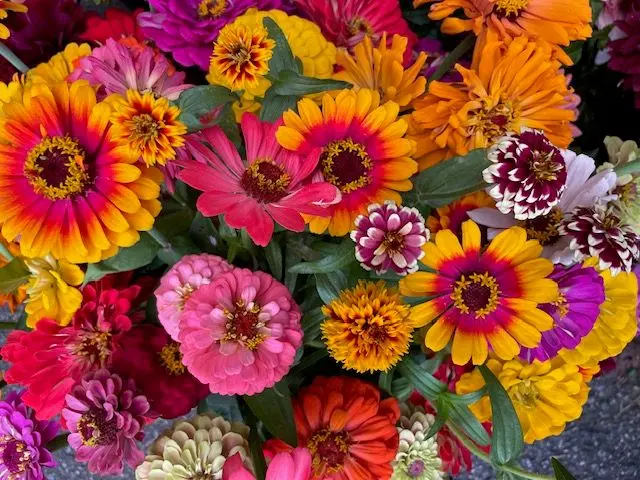Locally grown success for Chesapeake Flower Exchange
03/25/2024| Anna Mishonova
Locally grown success for Chesapeake Flower Exchange
03/25/2024 | Anna Mishonova
Something as delicate and beautiful as a flower requires a surprising amount of labor to produce, and Chesapeake Flower Exchange (CFE) knows that very well. What started as a small community of growers supporting each other has blossomed into a successful young company that recently celebrated its first year in business.
Company President Lisa Derx and Secretary Kristi Gill are both happy and hopeful for the future. “We consider our first year to have been a great success! The market and demand for local flowers seems to be growing more and more, and Chesapeake Flower Exchange is ready to meet that demand,” said Kristi.
Campanula flowers in three variations: white, light purple, and dark purple.
CFE emerged very naturally through a couple years of community collaboration and support. When a local flower producer did not have the specific flowers that a customer requested, other growers would step in to help cover the order. The group also shared large-scale orders for plants, seeds, and bulbs, making it cheaper and easier for small farms to get the products they needed. “It has always been an incredibly supportive and helpful community,” said Kristi.
The company currently unites 10 local farms that deliver up to 50 miles from Central Maryland, which includes Baltimore, Washington, D.C., Annapolis, and Northern Virginia. The collective eventually plans to expand and add other growers to its network in order to meet the rising demand for locally grown flowers.
“Consumers are paying more attention to where the goods they purchase come from and from whom, and flowers are no exception,” said Kristi. “Local flowers grown in season will trump imported flowers in quality every time. They are cut fresh to order and delivered right away.”
In turn, imported flowers (mostly delivered to the U.S. from Colombia) are shipped out of water and sometimes under refrigeration to survive a journey that can last days or weeks before reaching their destination. After arriving, flowers are usually “shocked” back to life using preservatives, which can impact their overall health and longevity. The transportation requires a lot of care and materials, increasing both the carbon footprint and the end cost for the customer.
On the other hand, locally grown flowers can easily compete with imported flowers in price, quality, and appearance, Lisa notes. Moreover, they allow for Maryland pollinators to thrive; some of CFE growers collect and sell honey in addition to flower farming.
Dahlia flowers blooming on the farm.
“Dahlias are by far a best seller for us. Not only are they beautiful and available in a wide range of colors and shapes, but they do not ship well, and so they must be purchased from a local source,” said Kristi. “Daffodils, tulips, sunflowers, ranunculus, anemones, and mums are also popular, depending on the season.”
A helpful factor that made the company’s first year successful was the support it received from the Rural Maryland Council : the business was awarded a grant to help with start-up costs. Additionally, the Howard County Economic Development Authority served as the company’s fiscal agent when they were not yet a legal entity. Lisa says she appreciates the power of networks.
“Thanks to a referral from the Rural Maryland Council, we also benefited from Keystone Development Company. Several of our members participated in their Cooperative Academy, learning about legal issues, finances, and good communication techniques,” said Lisa. “We believe in working collaboratively, so we will continue to seek partnerships that will help us achieve our goals.”
While the company’s success may prompt some to think growing flowers is easy, this craft is no walk in the park. There are plenty of factors impacting the business: weather at home can affect the local crops (like the extremely dry summer of 2023), while weather abroad can disrupt the supply chain for seeds and bulbs. There are also pollinators, weed and pest pressure - in short, a lot of things can go wrong when growing flowers.
“It takes purpose and resilience to succeed,” said Lisa.
Dianthus flowers covered with a net.
With its success, CFE is looking forward to expanding its operations. “We plan on moving into a dedicated space and potentially offering retail options,” said Kristi. “We are also excited to grow our customer base and expand on our available offerings.”
To see what CFE has to offer or learn more about their Maryland growers community, visit their website at chesapeakeflowerexchange.com .
Keep up with the latest.
Sign up for e-mail notifications.
